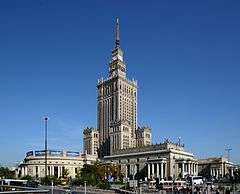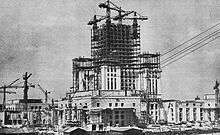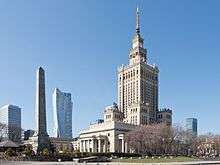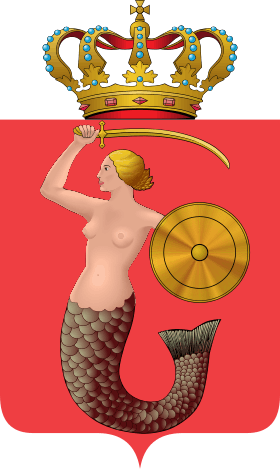Palace of Culture and Science
Palace of Culture and Science (Polish: Pałac Kultury i Nauki; abbreviated PKiN), is a notable high-rise building in central Warsaw, Poland. With a total height of 237 metres (778 ft) it is the tallest building in Poland, the 5th-tallest building in the European Union (including spire) and one of the tallest on the European continent.[1] Constructed in 1955, it houses various public and cultural institutions such as cinemas, theatres, libraries, sports clubs, university faculties and authorities of the Polish Academy of Sciences. Since 2007 it has been enlisted in the Registry of Objects of Cultural Heritage.
| Palace of Culture and Science | |
|---|---|
Pałac Kultury i Nauki – PKiN | |
 Palace of Culture and Science in 2011 | |

| |
| General information | |
| Type | Multi-function |
| Architectural style | Socialist realism and art deco |
| Location | Warsaw, Poland |
| Address | Plac Defilad 1 |
| Coordinates | 52°13′54″N 21°00′23″E |
| Construction started | 2 May 1952 |
| Completed | 22 July 1955 |
| Height | |
| Architectural | 237 m (778 ft) |
| Antenna spire | 237 m (778 ft) |
| Roof | 187.68 m (615.7 ft) |
| Observatory | 114 m (374 ft) |
| Technical details | |
| Floor count | 42 |
| Floor area | 123,084 m2 (1,324,865 sq ft) |
| Design and construction | |
| Architect | Lev Rudnev |
| Other information | |
| Number of rooms | 3288 |
| Website | |
| www | |
Motivated by Polish historical architecture and American art deco high-rise buildings, the PKiN was designed by Soviet architect Lev Rudnev in "Seven Sisters" style and is informally referred to as the Eighth Sister. The Palace was also the tallest clock tower in the world until the installation of a clock mechanism on the NTT Docomo Yoyogi Building in Tokyo, Japan.
History
Name

The building was originally known as the Joseph Stalin's Palace of Culture and Science (Pałac Kultury i Nauki imienia Józefa Stalina), but in the wake of destalinization the dedication to Stalin was revoked.[2] Stalin's name was removed from the colonnade, interior lobby and one of the building's sculptures.
Some Varsovians still commonly use nicknames to refer to the palace, notably Peking, because of its abbreviated name PKiN), and Pajac ("clown", a word that sounds close to Pałac). Other less common names include Stalin's syringe, the Elephant in Lacy Underwear, Russian Wedding Cake, or even Chuj Stalina ("Stalin's Dick").[3][4] A popular saying among some of the locals has surfaced in the past few decades which insinuates that the Palace's observation deck has the city's "best view because it’s the only place in Warsaw with no view of the building".[5]
Construction


Construction started in 1952 and lasted until 1955. A gift from the Soviet Union to the people of Poland, the tower was constructed, using Soviet plans, by 3,500 to 5,000 Soviet workers and 4,000 Polish workers. Sixteen workers died in accidents during the construction.[6] The builders were housed at a new suburban complex built at Poland's expense, with its own cinema, food court, community centre and swimming pool, called Osiedle "Przyjaźni" (Neighborhood of Friendship).[2][7] The architecture of the building is closely related to several similar skyscrapers built in the Soviet Union of the same era, most notably the Main building of Moscow State University. However, the main architect Lev Rudnev incorporated some Polish architectural details into the project after traveling around Poland and seeing the architecture.[6] The monumental walls are headed with pieces of masonry copied from Renaissance houses and palaces of Kraków and Zamość.[6]
Shortly after opening, the building hosted the 5th World Festival of Youth and Students. Many visiting dignitaries toured the Palace, and it also hosted performances by notable international artists, such as a 1967 concert by The Rolling Stones, the first by a major western rock group behind the Iron Curtain.[8] In 1985, it hosted the historic Leonard Cohen concert, surrounded by many political expectations, which were avoided by Cohen in his prolonged introductions during the three-hour show.[9]
Four 6.3-metre (21 ft) clock faces were added to the top of the building ahead of the millennium celebrations in 2000.
Present day

The building currently serves as an exhibition centre and office complex. The Palace contains a multiplex cinema with eight screens,[10] four theatres (Studio, Dramatyczny, Lalka and 6. piętro), two museums (Museum of Evolution and Museum of Technology), offices, bookshops, a large swimming pool, an auditorium hall for 3,000 people called Congress Hall,[11] and an accredited university, Collegium Civitas, on the 11th and 12th floors of the building. The terrace on the 30th floor, at 114 metres (374 ft), is a well-known tourist attraction with a panoramic view of the city.[12]
The Congress Hall held the finals of Miss World 2006.[13]
In 2010, the illumination of the building was modernized and high-power LED lights were installed, allowing the Palace to take various colours at night.[14] The first use of the new lighting was during Christmas in 2010, when the Palace was illuminated in green and white to resemble a Christmas tree.[15] In December 2013, during the Euromaidan protests, it was illuminated in yellow and blue, the colours of the Ukrainian national flag as a sign of solidarity with the protesters.[16]
Controversy
The Palace of Culture and Science is a highly controversial building for some, and is often viewed as a reminder of Soviet influence over the Polish People's Republic, especially due to its construction during mass violations of human rights under Joseph Stalin.[5] A coalition of veteran and nationalist groups in Poland as well as numerous right-wing political parties have called for its demolition.[17] In 2009, then Foreign Minister Radoslaw Sikorski supported the demolition of the Palace noting the expense involved in its maintenance.[18] Other prominent government leaders have continued to endorse demolition plans, including current Prime Minister Mateusz Morawiecki.[19] However, others reject the idea noting that the Palace became one of the symbolic buildings of Warsaw.
See also
- Eighth Sister
- Latvian Academy of Sciences in Riga
- Casa Presei Libere in Bucharest
- Museum of Communism, Warsaw
- Neoclassical architecture
- Parade Square (Plac Defilad)
- Socialist realism in Poland
References
- "History of the Palace" Archived 22 June 2019 at the Wayback Machine, at the official website (retrieved March 22, 2016)
- "Warsaw Palace of Culture and Science" (PDF). Best Urban Freight Solutions. 24 May 2007.
- "Warsaw: Don't Miss". www.whatsonwhen.com. Archived from the original on 16 August 2011. Retrieved 25 July 2008.
- Małgorzata Barwicka (7 March 2007). "Pałac pod lupą". www.tc.ciechanow.pl (in Polish). Tygodnik Ciechanowski. Retrieved 29 July 2008.
- "The Movement to Destroy Warsaw's Tallest Building". nextcity.org. Retrieved 19 October 2018.
- "History of PKiN in a nutshell". www.pkin.pl. Archived from the original on 20 July 2011. Retrieved 25 July 2008.
- Pałac Kultury i Nauki "Historia" Archived 20 July 2011 at the Wayback Machine at the PKN official website.
- Timothy Tilghman. "The Stones Tumultuous 1967 European Tour". rockontour.net. Retrieved 25 July 2008.
- "Leonard Cohen in Warsaw (1985) by Daniel Wyszogrodzki". Leonardcohenfiles.com. 22 March 1985. Retrieved 29 October 2012.
- "Kinoteka: Wynajem sal". Archived from the original on 30 January 2015. Retrieved 29 January 2015.
- Magdalena J. Zaborowska. "The Height of (Architectural) Seduction: Reading the "Changes" through Stalin's Palace in Warsaw, Poland". Centre for Cultural Research, University of Aarhus. Retrieved 18 April 2008.
- "Pałac Kultury i Nauki w Warszawie". www.pkin.pl. Retrieved 4 March 2020.
- "Miss World 2006". www.cbsnews.com. Retrieved 4 March 2020.
- "Stolica: ponad dwa miliony na oświetlenie Pałacu Kultury" (in Polish). Onet Wiadomości. 10 September 2010. Retrieved 1 February 2015.
- "Świąteczne oświetlenie Pałacu Kultury i Nauki w Warszawie" (in Polish). RMF24.pl. 23 December 2010. Retrieved 1 February 2015.
- "Pałac Kultury podświetlony w barwach Ukrainy [ZDJĘCIA]" (in Polish). Wyborcza.pl Warszawa. 5 December 2013. Retrieved 1 February 2015.
- "Call to Demolish Warsaw's Palace of Culture as an 'Architectural Monstrosity' and 'Affront to Poland' | Inside-poland.com". inside-poland.com. Retrieved 19 October 2018.
- "Call for demolition of Polish palace". 17 November 2009. Retrieved 19 October 2018.
- AFP, Pulse News Agency International by. "In Poland: Top politicos "dream" of demolishing Stalinist palace". Retrieved 19 October 2018.
Further reading
- Michał Murawski (2019), The Palace Complex: A Stalinist Skyscraper, Capitalist Warsaw, and a City Transfixed, Indiana University Press, ISBN 978-0-253-03996-5
External links
| Wikimedia Commons has media related to Palace of Culture and Science. |
.jpg)
